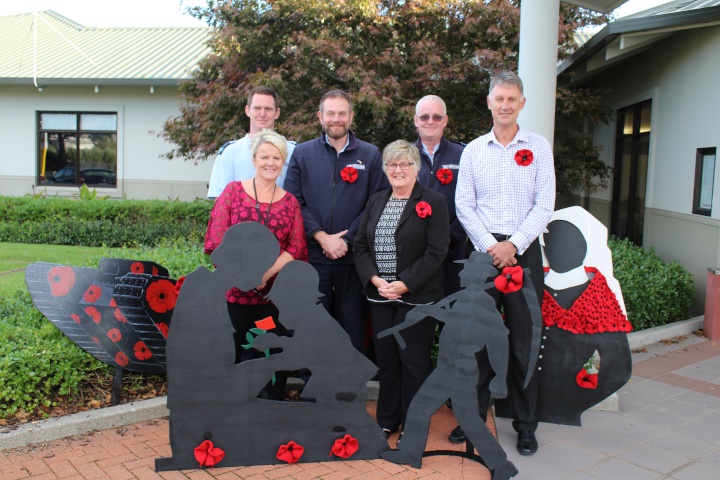ANZAC displays can be enjoyed until the end of May
Waikato district ANZAC displays can be enjoyed until
the end of May
People
wanting to see the ANZAC art installations in the Waikato
district have until the end of May to see them.

Waikato District Council will
not be removing the poppy ‘yarn bombing’ along the Te
Awa cycleway at Ngaruawahia or an art installation at the
Council until the end of May, and is encouraging groups who
yarn bombed ‘poppy trees’ in 21 communities around the
district to keep their decorations up until the end of May
as well.
The ANZAC art installation at the Council’s offices in Ngaruawahia combines yarn poppies with plywood art cutouts created by prisoners at Spring Hill Corrections Facility.
They include portrayals of a tank, ship and warplane representing the troops who served and died, and other silhouettes representing those who remained at home. They are on display outside and in the foyer of the Council offices, where visitors attending meetings in the Council Chamber can also see a tree ‘yarn bombed’ with knitted red poppies.
The plywood silhouettes complement the Council’s district-wide ANZAC ‘yarn bombing’ street art project that encouraged community groups to knit more than 8,000 poppies to decorate trees in 21 townships around the district, and a one-kilometre stretch of the Te Awa cycleway and Perry Bridge in Ngaruawahia. Waikato district school children also took part by knitting camouflage nets decorated with poppies to ‘yarn bomb’ two tanks outside the National Army Museum in Waiouru. This art installation will also remain in place until the end of May.
Waikato District Council acting Chief Executive Tony Whittaker says, “The Council has welcomed the involvement of Spring Hill Corrections Facility in a project that has brought our communities together to create visual pleasure in our district and further afield.”
Corrections Instructor Andrew McBean says, “The prisoners were excited by the project and were able to demonstrate their artistic flair and contribute back to their community. We have appreciated the opportunity to be part of this interesting local project which will enhance the skill levels of prisoners and help with their reintegration back into the community.”
Having a job reduces the likelihood of an
offender re-offending and means they can provide for
themselves and their family, connect with pro-social support
and gives them a sense of pride. Engaging in employment and
industry training such as carpentry, enables prisoners to
gain real work experience and employment skills, making it
easier for them to find work on release.
Ends


 Gordon Campbell: On Why We Can’t Survive Two More Years Of This
Gordon Campbell: On Why We Can’t Survive Two More Years Of This Queenstown Lakes District Council: Top 10 Most Hazardous Items Found In QLDC’s Waste Facilities And Rubbish And Recycling Bins In 2024
Queenstown Lakes District Council: Top 10 Most Hazardous Items Found In QLDC’s Waste Facilities And Rubbish And Recycling Bins In 2024 NZ Government: Drive Safely This Summer
NZ Government: Drive Safely This Summer Northland Inc: Game-Changing Investment For Northland - Resilience Fund Allocates $250,000 To Health Simulation & Training Centre
Northland Inc: Game-Changing Investment For Northland - Resilience Fund Allocates $250,000 To Health Simulation & Training Centre Interchurch Bioethics Council: Church Bioethics Agencies Express Dismay at the Rushed Consultation Period for Submissions on the Gene Technology Bill
Interchurch Bioethics Council: Church Bioethics Agencies Express Dismay at the Rushed Consultation Period for Submissions on the Gene Technology Bill New Zealand Police: More Than $2.5m Worth Of Assets Restrained In Undeclared Tobacco Case
New Zealand Police: More Than $2.5m Worth Of Assets Restrained In Undeclared Tobacco Case SPCA: Survey Shows Government Lacks Mandate To Repeal Live Export Ban
SPCA: Survey Shows Government Lacks Mandate To Repeal Live Export Ban


